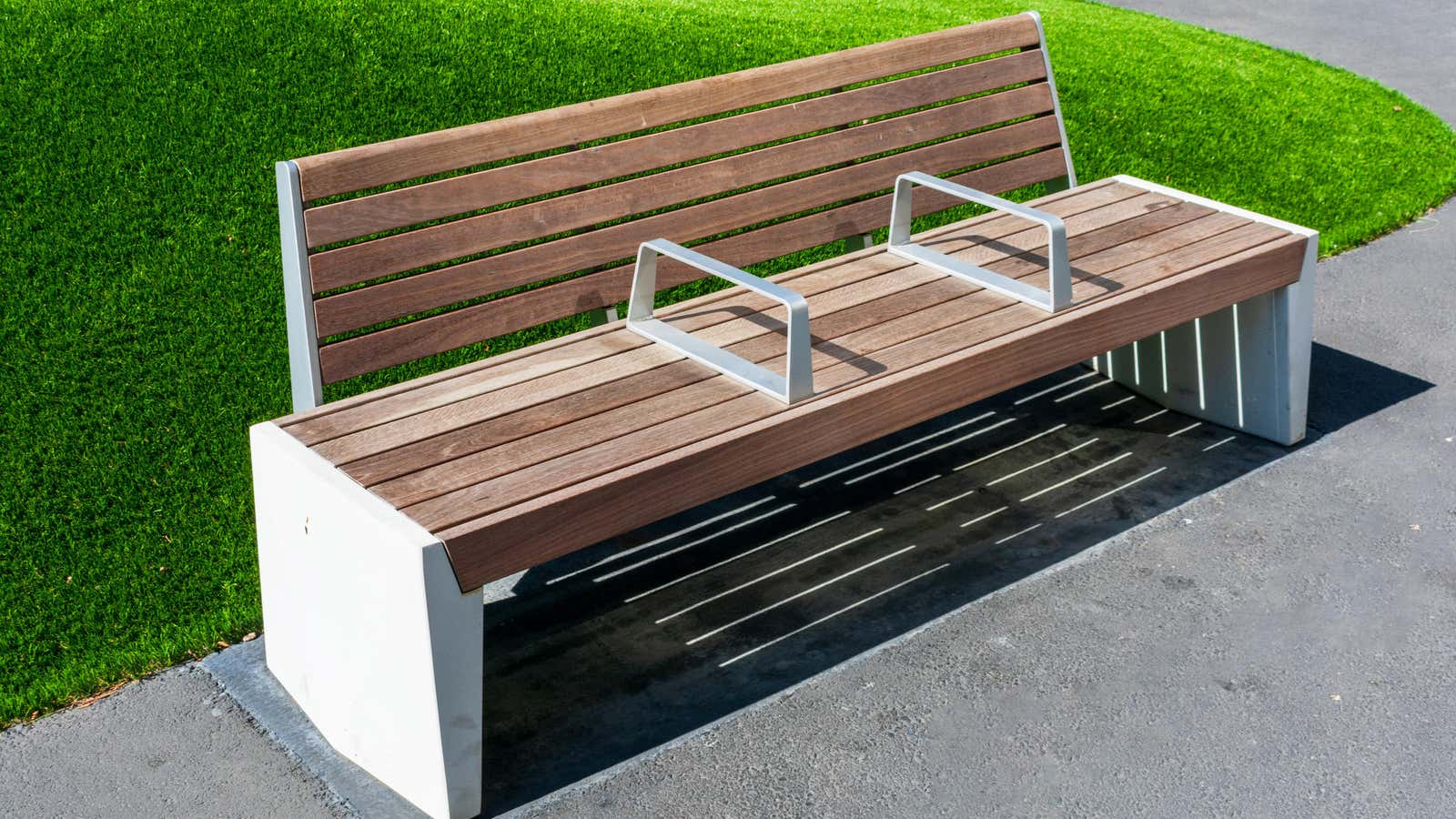How to Define Architecture Against the Homeless (and What to Do About It)

Public spaces should be free and open to all, which is usually what the word “public” means. But as the incredibly high cost of living leaves more and more people homeless, the definition of public space is narrowing down to purposefully exclude them. Businesses and city governments most often do this at the cost of hostile architecture that makes it inconvenient or impossible to relax in public.
Hostile architecture (or hostile urban design) is a way of designing public spaces that discourages or prevents certain behaviors, usually sleeping, sitting, and/or skateboarding. This allows designers to purposefully exclude certain types of people—in particular, the homeless and, to a lesser extent, teenagers—from a given area. In fact, hostile architecture is so widely used to attack the homeless that many of the more common examples are now referred to as “anti-homeless architecture”. Here’s how to determine it.
What is “anti-homeless architecture”?
The anti-homeless architecture can be incredibly obvious, but more often than not, it’s designed to provide at least a little plausible deniability. Segmented benches are the most common example: these “armrests” don’t really allow anyone to lie down (and also many fat people to sit comfortably). In some cases, benches may not be segmented, but tilted, tiered, curved, or otherwise impossible to lie on. Sometimes people deliberately place decorative design elements such as trees, rocks, and flower pots where people camp; even infrastructure as useful as bike racks can be misused .
However, sometimes anti-homeless architecture is more outspoken in its intentions. This is when you get things like spikes and rough rocks on any flat surface, especially under bridges; barred corners and enclosed heating grills send an even clearer message to anyone looking for a place to sit. In some cases, businesses will deter camping by flashing bright lights and/or sounding loud alarms . Music can also be used to combat the homeless: In 2019, the Waterfront Lake Pavilion in West Palm Beach, Florida screamed “Baby Shark” and “It’s Raining Tacos” all night so no one could sleep there.
These are just some of the many examples. Basically, if it looks, feels, and/or sounds like the space was deliberately designed to make recreation impossible, it probably was—regardless of what anyone says to the contrary.
Why hostile architecture is terrible
The first and most important problem with hostile architecture is that it is inhumane. Forbidding someone to sit or lie down in public is just cruel, and even worse when they have nowhere else to do it. The second problem is that many people in power see this as a legitimate way to address homelessness. This is not true: the cause of homelessness is an insufficient supply of housing, rising rents and stagnant wages. Dropping boulders on the pavement does not solve exactly one of these problems – it just puts people in even more dangerous living conditions.
If brutality wasn’t enough, anti-homeless architecture is also incredibly expensive. For example, last year in Portland, Oregon, the city council approved a $44 million public safety spending bill that provided $500,000 to install anti-homeless benches on the southern boundary of Laurelhurst Park. So far, those benches haven’t materialized – likely due to public backlash against the concept of spending half a million dollars on benches – but it’s a good example of how much cities are willingly spending to ban certain residents from public spaces. This begs the question: if homelessness is such a big problem, why not spend money on housing and services rather than costly punitive measures that only exacerbate the problem?
The answer is that, at least in the US, many people believe that homelessness is bad, not because human suffering is bad, but because people sleeping on the street negatively affect their business, property values, and feelings. so they take out their city councilors and mayors. “do something” with it. Politicians are often too happy to oblige, which means more camp cleanups, more arrests, and more anti-homeless urban design, all of which they can justify by citing how many complaints they receive.
What can you do about it
If you notice a growing number of anti-homeless buildings in your area, there is something you can do to help by filing a complaint. Complaints approve these projects, and they can also close them. Find out who is responsible for the feature: who requested it and why? Who approved it and why? Who installed it and how much? Then let them know what you think about it, ideally in writing. For even more impact, ask your friends and neighbors to complain as well.
You should also avoid businesses that promote anti-homelessness in your area, not just those that install hostile structures in front of the entrance. Many business owners proudly display their fierce views at every opportunity, especially on social media, so it’s pretty easy to see what they’re based on. You may also consider joining a housing advocacy group. The current surge in urban design against the homeless may be relatively young, but the problems they exacerbate are certainly not. Wherever you live, people are already working to make life better; if you’re serious about getting help, start here.
All this is doubled (or tripled) for people who already have houses. Homeowners and neighborhood associations have a lot of power in local politics, and not always in a good way. If you don’t have a “fuck you, got mine” mindset, it’s incredibly important that people know about it, especially your HOA assholes.